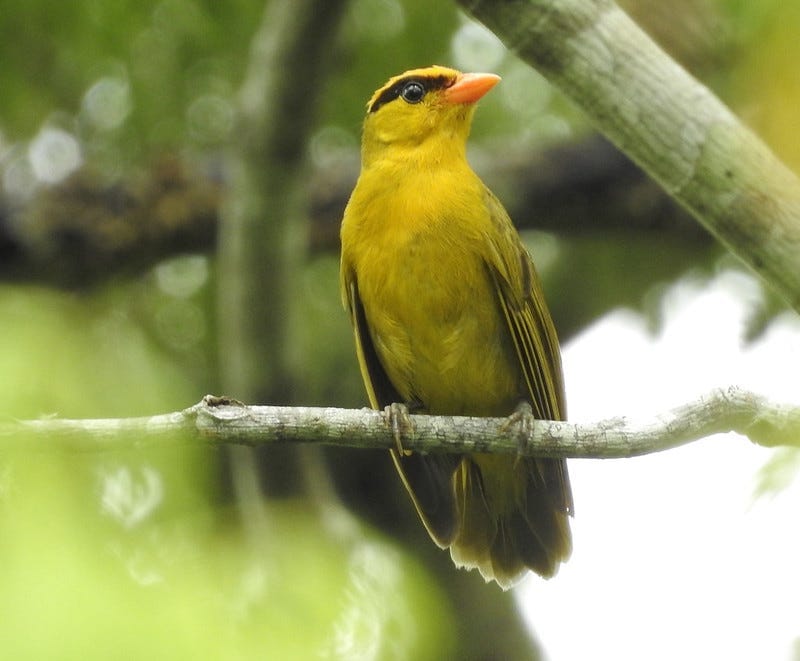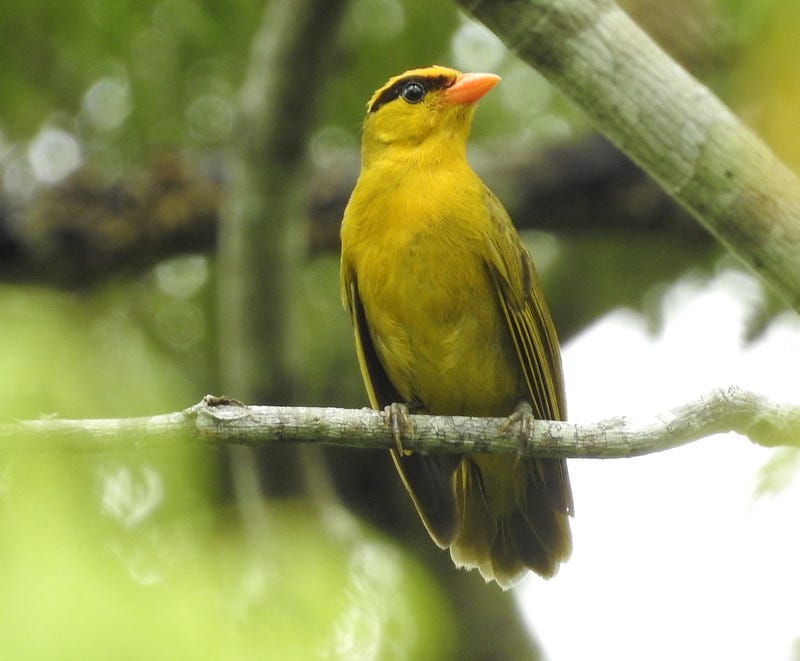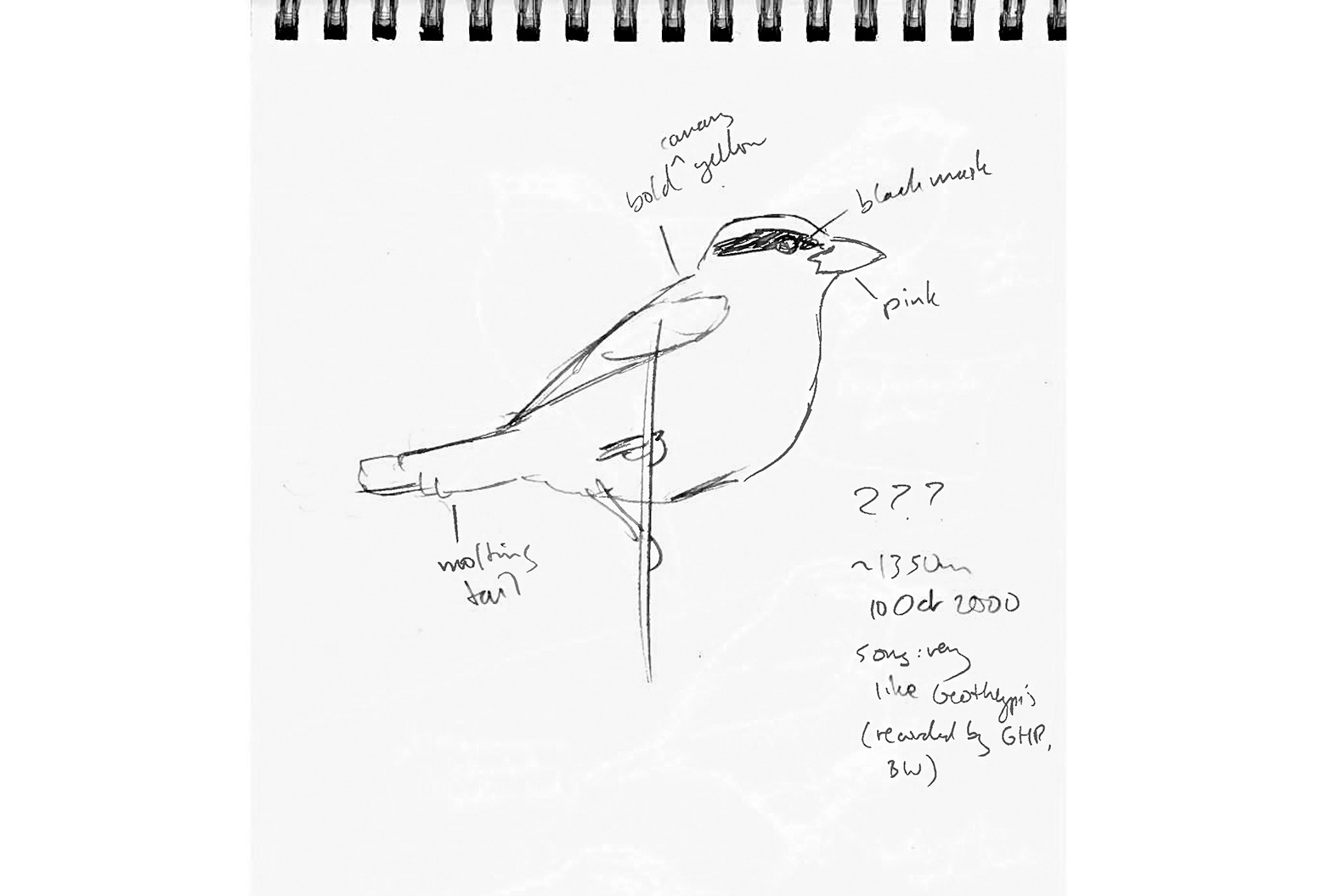Indignity Vol. 1, No. 40: Tanager of the Year
NATURAL HISTORY DEP'T.

A shorter version of this interview also appears on Slate.

They Found a New Bird!
ON OCTOBER 10, 2000, while guiding an ecological tour group along the edge of Manu National Park in Peru, the naturalist Daniel Lane, a research associate with the Louisiana State University Museum of Natural Sciences, saw something he was "entirely unprepared for": a strikingly bright yellow bird with a black eyebrow and a pink bill.
The location was "one of the ornithologically best-studied sites in Peru," Lane and a team of seven other researchers wrote in the current edition of the journal Ornithology, yet no one had reported such a bird there before. Lane's LSU colleague Gary Rosenberg also glimpsed it, but the bird flew off before anyone else could see it, leaving Rosenberg with a brief recording of its song and Lane with a quick pencil sketch.
After two more decades collecting observations, recordings, photos, and specimens across Peru and Bolivia, Lane, Rosenberg, and their colleagues conclude in their new paper that the bird is a previously unknown species—and genus—of tanager, part of a diverse, numerous, and often colorful family of songbirds. Unlike most other tropical birds, it appears to migrate over short distances, leaving its breeding grounds in forested valleys in Bolivia to appear in the lower slopes of the Andes in Peru. It appears to hide and forage in dense, low-growing bamboo in both places; researchers have seen the birds beating a spider and a grasshopper to death and swallowing them, and eating cactus fruit.
The team named their find the inti tanager, after the word for "sun" in the indigenous Quechua and Aymara languages, with the proposed species name Heliothraupis oneilli. Heliothraupis, they wrote, combines the Greek helios, for "sun," with thraupis, "meaning 'finch' or 'small bird,' but in current usage usually referring to tanagers." Oneilli is a tribute to the LSU ornithologist John O'Neill, who helped establish ornithological research in Peru and who in 1964 discovered the orange-throated tanager, Wetmorethraupis sterrhopteron, there—alerting natural historians that there were still new birds to be found even where, as O'Neill wrote at the time, "the bird life of the country as a whole is reasonably well known.”
The new publication comes one month after the United States Fish & Wildlife Service removed the ivory-billed woodpecker, Bachman's warbler, Guam's bridled white-eye, and eight different birds indigenous to Hawaii from the Endangered Species List, on the ground that they are all fully extinct. Their last known sightings ranged from 1944 for the ivory-bill (the country's largest woodpecker, with a two-and-a-half-foot wingspan) to 2004 for the po 'ouli (a Hawaiian honeycreeper with a black face, which had only been discovered in 1973).
In a phone interview, I asked Lane what it was like to see something no other scientist had seen before. The transcript has been edited for length and clarity.

What happened the very first time you saw the bird? You were guiding an eco tour, in Peru?
Do you want the short version or the long version?
The long version would be great.
All right. Basically, I was working for a bird tour company called Wings at the time. And this was my first tour to southeastern Peru—my first time actually birding in southeastern Peru. But I had spent several years at LSU, I'd kind of had the time to memorize a lot of the birds that would be likely in the area. So I felt pretty prepared for going down there.
I was co-leading with Gary Rosenberg. And we also had another fellow named Barry Walker along, who was sort of an unofficial third guide. Barry is a British expat who lives in Cusco and is sort of a walking font of knowledge on birds in Peru. So he was along to keep us on the straight and narrow if we got off into the weeds.
This road, the Manu Road, comes from the city of Cusco, it crosses over a high pass, which is above the treeline, and then it descends down a series of valleys. So you're getting this cross-section of, jeez, I don't even know, it's about 3,000 meters of elevation.
So we were starting our last day, descending down into the lowlands. At this particular elevation, at about 1,400 meters, it's high-diversity, and a lot of these small forest birds tend to move in mixed-species foraging flocks. When you encounter one of these flocks, it's high-impact birding. These birds are moving quickly, and they're hiding in leaves and foraging and fluttering and catching insects. There's so much going on at once, and they can pass through in 15 minutes. So it's a situation where you're sort of in triage mode as a tour guide, trying to choose which birds are most important to show to your clients before the flock disappears and you lose the opportunity.
So this flock was in front of us, and we were desperately trying to point things out. And in the background, I was hearing a birdsong. This was, as I said, my first visit to the region, and the thing that I sort of latched on to with this birdsong is it sounded a bit like a yellowthroat. There's a species in that part of Peru called masked yellowthroat, which is typically found in second growth. I figured, as we continue down the road, when we get into where there's more people, we're probably going to run into this bird. So it's not something that's high priority to show to the group. I was kind of ignoring this birdsong.
But after a little while a bird flew up and landed on the very top of a damaged tree trunk, quite tall, and started belting out this song. And that's not the behavior of a yellowthroat. So I immediately looked at it with my binoculars, and it was far enough away, I couldn't really see detail. So I then turned to my telescope and put it in my telescope. And it didn't add up. It wasn't something that looked at all like anything I was expecting to see in this region.
I turned to Gary Rosenberg, who was standing right beside me, and said, "Gary, you gotta see this thing and tell me what you think." And he looked through my telescope and he stepped away and said that to him, it looked like—there's a family of birds in the Old World called orioles, the original orioles. And there's a couple in Asia and Africa that have sort of canary yellow plumage, a pink bill, and a black eyebrow. Those are the features we were seeing on this bird. So he said, "Well, I mean, all that's coming to mind is one of these Asian or African orioles."
I said, "That's exactly what came to my mind," even though that's obviously not possible. Those birds just simply won't be turning up in South America. So we turned to Barry Walker. Barry stepped up to the telescope. And all he saw was a bouncing branch. The bird had departed the tree, just before he looked through the scope. So he never saw it.
And we didn't really announce this thing to the group. It's just the two of us, Gary and me, sort of just trying to make sense of what we just saw—something that just didn't look like anything that was meant to be there.
Gary managed to get about five seconds of the bird's song in a recording. And I immediately did a sketch. The bird flew from that tree and it disappeared over a ridge and it would not come back. We were kind of on a schedule; we had to keep moving. We didn't understand what we'd just seen, although at that point I had already had the opportunity to be a participant in the discovery of a new species, so I was getting the inkling that very possibly it was something along those lines.
What was the previous new species?
It was on my very first trip to Peru, actually, I don't know if you have the Birds of Peru field guide, but if you were to look on Amazon, the front cover has this very colorful bird called a scarlet-banded barbet, and I was the lucky first person to see that bird in life. That was a bit of an inauguration for my career, unexpected and very welcome. But perhaps too much too soon, you know, for a 22-year-old kid.
So I had that sort of Spidey sense in the back of my mind that this may very well be something new. But we passed the sketch and the song recording around to experts in neotropical birds and tanagers in particular, because we figured it was very likely going to be a tanager. And everyone basically gave us the same response. They kind of gave us this slightly skeptical look and said, "Are you sure that's what you saw?" A sketch is not the same as a photograph, it's obviously something that can be affected by the observer's impressions.
We were doing this tour every year at about the same time in October. So we did the tour again, in 2001, and 2002. And I was very much sort of hoping that we would run to this bird again, but there was just no sign of it. I think in 2001, I went there on my own, to see if I could encounter the bird apart from a tour group, where I had more time to really put an effort into it, and I just could not come up with the bird.
In 2002, by that point, I was really seriously starting to doubt what we had seen. The song that Gary made the recording of did sound a bit like a bird called a brown-capped vireo. And there is the phenomenon of plumage pigment issues—albinism, for example. We've got specimens here at LSU of some common birds that are missing their melanins, their dark pigments, but they still have their yellow pigments and so they look like a yellow canary even though normally they would look green or dark brownish. These plumage colors are created by layered pigments of different types that your eye picks up as a single color.
So I thought, well, perhaps this could be a situation where this was a vireo that was missing its melanins, but had its yellow pigments, but it had a bit of a retained melanin around the face. And it had a pink bill. I was trying to come up with some explanation.
But then in 2003, on the same tour again, Gary and I were turning that same corner, it was the same sort of respective day of the tour, when we're heading downslope. And as we turned the corner, I heard that song off in the distance, and I turned to Gary and I said, "Gary, I think that's our bird."
And so we walked up to the sound, and I got recordings of it, and played the recording back, and the bird just popped right up on the top of the tree in full view of everybody in the group. It was exactly the same thing, canary yellow, pink bill, black eyebrow. And the group was looking at it through the telescope, and I was making recordings. At that time, 2003, digital cameras were not what they are today. I guess nobody in the group had a film camera. Gary would put his camera up to the telescope to get photographs.
But of course, you have to first allow the tour participants to look through the scope, because they're paying you to do it. By the time the last participant got their last look, and Gary stepped up on the scope, the bird flew, and it wouldn't come back. So we didn't get a photograph of it.
But we were absolutely certain this thing was new. This was a new species. And it seemed to be a tanager. We had better documentation. I made another sketch, I had much better recordings.
You named the bird after John O'Neill, who had discovered the orange-throated tanager in 1964, in what sounds like a similar situation where the bird life was pretty well documented, and he wasn't expected to find it.
I'm not sure I would quite say it that way. Basically, what had happened was, Peru, I think most people recognize, was still relatively poorly known. Most of the knowledge was basically in cabinets in museums. This was back in the 1930s through '50s. The thought, by ornithologists in general, was that the birds of the world were pretty much known. New species were being discovered here and there, but it was never anything really attention-grabbing. There were mostly these kind of little brown things that were just a slightly different variation of some other little brown thing.
In most cases, these were folks who had never even seen these birds alive. They were receiving specimens from collectors in those countries, but they were basically staying in Europe or North America and receiving specimens and describing them based on these specimens. They had no idea about the natural history, the actual behavior, the voice or whatever, of these birds, for the most part.
It wasn't really until the ’60s that the folks who were doing the museum ornithology were also the folks who were in the field collecting the specimens. That was a relatively recent phenomenon. And John was at the forefront of that. And so John's thing was, after having, you know, these world-renowned ornithologists like Ernst Mayr and Alexander Wetmore basically pronounce that we have effectively found most of the birds on the planet, we're just filling in the gaps now, and they're mostly these kinds of variations on a theme kind of thing.
And then John found this tanager that just blew that ship out of the water, this thing that was so different, it was a new genus. This was an obvious case that suggested, in fact, there's still a lot yet to be discovered. And that was what started the whole program here at LSU. Which has resulted in the description of—it's got to be now 30 new species of birds since 1964, by different colleagues of the LSU Museum of Natural Science, of which I'm one. It set these precedents for South America, but also there's folks who are doing work in Africa and Asia, uncovering lots of new species. It's just been kind of a steamroller effect. It's been kind of amazing how much new stuff is still out there, even today.
How many times have you seen this bird, total?
I've seen it three times in Peru, and I guess on two occasions in Bolivia. In Peru, I've seen it for only a few minutes to, at most an hour, in any given observation. In Bolivia, we camped where they're breeding and they're much more obvious and easier to find, so several, several different days each visit. But basically, five times.
And from initial sighting to publication, it's been 21 years.
It's been a long time. Longer than I would have liked, if I'd had my druthers.
Where's the point where you're able to declare?
How does that all unfold? Obviously, documentation is the most important thing. Humans are prone to factual error and to exaggerating, so science does require hard documentation that is objective that other people can review and come to their own conclusions on.
The general accepted standards are to have a type of specimen, or even better, a series of specimens. These are museum skins that can be used to investigate and compare to related forms. In the modern day, those specimens are almost always now associated with additional information like tissue samples, maybe sound recording or video or photographs in the field. And there's a lot more information on tags associated with those specimens today than there would have been 100 years ago.
We still collect specimens, you know. I think a lot of folks are surprised to hear that, but it's still very much an important part of modern ornithology. We're looking at plumage molt, and gonad status, stomach contents, fat reserves; we age them based on a couple of physiological characters, and so on. Specimens are very, very crucial to documenting these individuals, especially in cases where a new species is not distinctive, where it looks very much like a relative.
In this particular case, the bird is really quite distinctive, there's nothing else that looks like it. So we were certain from the beginning that we had something new. What we didn't know was where this bird fit into the family tree of birds. We needed tissues that we could send to one of my authors, Kevin Burns, who is an expert on tanagers and related birds.
In the course of his studies, he's shown that that family and the related families were actually sort of poorly defined. Here in the United States, we have a couple of birds we call tanagers—scarlet tanagers, western tanagers. But in fact, his studies show that those are not tanagers, those are actually related to our cardinal and to rose-breasted and black-headed grosbeaks, and so on. That's a different family. He also showed that a number of birds that we thought were finches and sparrows in fact, aren't sparrows. Those, in fact, are tanagers.
It made it a very important aspect of this discovery to actually be certain what this bird really was. Was it truly a tanager? Could it be a cardinal? Could it be something else? And so we needed the tissues. The very first specimen I got, unfortunately, the tissues were lost.
That was really the thing that held everything up. We could have described this thing in 2004, but it would have been a very bland description of an outstanding-looking bird, which would have been kind of a disappointment to me. I like the idea of having a story that's something that will actually make the paper have some teeth. And, you know, 21 years later, I think the paper does. I think that the story is kind of a fun one.
It's a fascinating read to get all this detail about this bird that's just been hiding in the low bamboo.
That's the big question, how has it been overlooked so long?
Is there any indigenous reference to a bird like this, that you know of?
Those regions where the bird occurs—I'm sure they've been populated for a very long time. But the history of Peru and Bolivia is probably not much kinder to indigenous peoples than ours here in the United States. And so there was no doubt a large die-off of indigenous peoples, once the Spaniards arrived, brought diseases and basically conquered the Incan Empire and the associated peoples who were at the periphery of it. So I suspect that if there had been sizable indigenous populations in the regions where this bird occurred, they probably died off hundreds of years ago.
More recently, these roads that have been put in in the past 50 years have drawn colonists from the highlands, from Cusco and from La Paz, down into the lowlands. So most of these colonists are not sort of folks who would have been from, you know, a long bloodline in the region, but rather, people who would have come from the highlands bringing Quechua or Aymara as the main language down to the lowlands, or Spanish, obviously. And so there's really no way to know if the original inhabitants would have been familiar with the bird. I suspect at least in Bolivia, probably yes, because it was quite abundant, when it's found in that valley. And the song is relatively ear-catching.
The paper mentions that there's a Chinese-backed road-building project that could potentially bring more people into the area. What's your sense of the overall ecological prospects for this bird?
The breeding habitat, this deciduous forest valley, is basically two-thirds inside a national park that doesn't really have access. There's no roads that lead into it, basically. You'd have to hike up the river valley to get up into this habitat. So happily, I would say that probably most of the bird's breeding distribution is inside a national park.
But the accessible part, the part that we visited, is right along this road. When I was there in 2019, I got to see that the road had been improved from what it had been in 2012, I'm still not certain if the project will go through to try to punch this road all the way to Rurrenabaque. If it does, I think it actually has to cut through the national park to do it.
At the present, there's not a really large population of people on this road. Should the road actually go to another city, there's gonna be a draw of colonists coming in, and deciduous forests are notoriously easy to clear compared to humid forests. This could be a serious conservation concern, because it's a really interesting valley apart from this bird, there's a lot of other things, a lot of plants, a lot of probably reptiles. It's a fascinating isolated patch of forest.
Was there anything particularly unexpected to you, in the course of these 21 years of work after the initial sighting?
Well, when Frank Rheindt reported to me that he'd found this breeding population in Bolivia. The bird up until that point had been extremely hit-or-miss in Peru. The Manu Road is the only access to that elevation band and habitat for basically 500 miles or 300 miles or something on either side. It's a very poorly sampled area because of its inaccessibility. That bird could have been, for all I knew, just super-abundant in a valley around the corner that no one had access to. And the occasional individual was kind of getting lost and coming over to the Manu Road.
So we intersected with a male on three separate occasions. But we didn't really understand what was that bird's life history—then suddenly, with this discovery of this abundant population in Bolivia, it fell into place, this business of intratropical migration, that the birds in Peru are maybe part of this low-density nonbreeding population.That was an eye-opening revelation.
Frank was the one who first sort of proposed that this thing could be a migrant. There are not a lot of tropical passerines that completely evacuate their breeding territories for some other place, especially small land birds found in the forest. This is a long-term habitat, and the bird just simply completely leaves it in the nonbreeding season, it seems. So that's pretty noteworthy.
Do you have your original sketch? Was it just pencil? What did you have to draw with?
Just pencil on—at that time, I was carrying around a sketch pad everywhere I went. I do dabble in bird art. Field sketching is something that I learned from a fellow named Don Eckelberry, who's one of my big art heroes, and I got to meet him as a teenager a couple times. He really drummed into me the importance of developing your ability to sketch birds by being in the field and doing it in the field. And so for 10 or 15 years, I was really doing that.

That's sort of been replaced most recently with—I carry a digital camera now. It's just so easy to get videos, which kind of just give you the observation you can look at at any time you want. So that's kind of replaced doing field sketches.
Finding this story on the heels of reading the Fish & Wildlife Service in September knocking however many birds, from the ivory-billed woodpecker on down, out of existence—it was sort of heartening.
It's kind of a nice way to see that, you know, we're not just losing things. We are gaining. Of course, it's not like this bird just appeared out of nowhere. It's been there all along. It's just, we didn't recognize it. Nevertheless, yeah, it is heartening to hear about new species that have only just come into the scientific and public consciousness in the past however many years. It's quite an honor for me to be playing a part in that, to actually have the opportunity to to be someone who can unveil some of these new species for the public.






